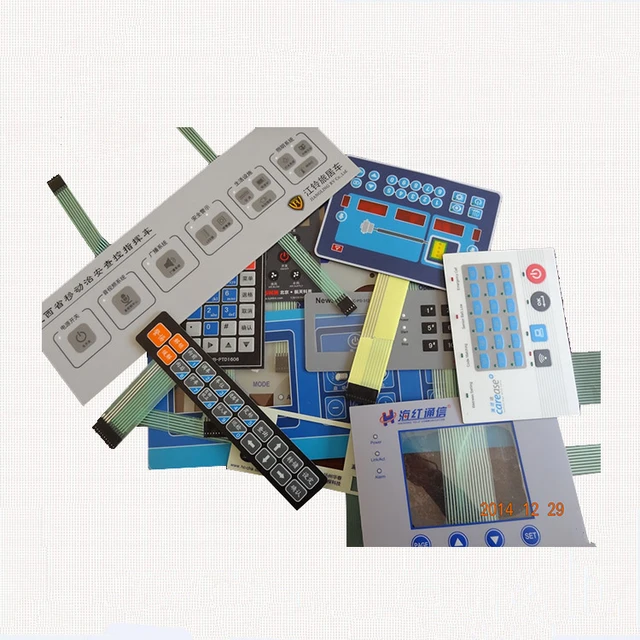Explore the Benefits of Using a Membrane Switch in Modern Devices
Explore the Benefits of Using a Membrane Switch in Modern Devices
Blog Article
Understanding Membrane Layer Switches: The Key to Trustworthy and durable Controls

What Are Membrane Layer Switches?
Membrane buttons are an advanced service in the realm of individual interface innovation, integrating functionality and layout flawlessly. These tools offer as a user interface in between users and digital systems, integrating several elements into a small style. Commonly created from adaptable, slim layers of products, membrane layer buttons are made to reply to touch, enabling individuals to communicate with machinery and electronic devices effectively.
The primary elements of a membrane layer button consist of a printed circuit layer, graphic overlay, and a spacer layer that avoids unintentional activation. The graphic overlay can be tailored to mirror brand name identity or user choices, boosting aesthetics while ensuring use. Membrane layer buttons are typically utilized in numerous applications, consisting of medical devices, customer electronic devices, and industrial equipment, owing to their durability and resistance to ecological elements such as moisture and dirt.
One of the key benefits of membrane switches is their capacity to endure wear and tear, making them excellent for high-traffic settings. Additionally, they are light-weight and need minimal room, enabling for innovative styles in product advancement. In general, membrane layer changes stand for a functional and efficient selection for contemporary digital interfaces, weding technology with user-centric layout principles.
Exactly How Membrane Switches Over Work
The operation of membrane switches over joints on a simple yet efficient device that converts user input into electronic signals. When an individual presses the button, the leading layer deforms, allowing a conductive aspect in the circuit layer to make call with an equivalent conductive pad on the bottom of the graphic overlay.
The design of membrane switches can vary, however they usually incorporate domes or tactile aspects to supply responses to the user, enhancing the overall experience - membrane switch. The materials utilized in membrane layer buttons, such as polyester or polycarbonate, add to their longevity and resistance to ecological factors, including moisture and dirt. Furthermore, the printed circuits Home Page are typically encapsulated, which safeguards them from deterioration gradually.
Benefits of Membrane Buttons

Furthermore, membrane layer buttons are known for their toughness. Created from durable products, they are immune to dust, moisture, and physical wear, which considerably expands their life-span contrasted to typical mechanical buttons. This durability makes them particularly suitable for high-traffic environments and applications requiring longevity.
Another significant benefit is the convenience of cleansing and maintenance. The smooth surface area of membrane layer switches over decreases dirt buildup and is usually unsusceptible spills, making them excellent for setups that need regular sanitization.
Furthermore, membrane switches supply a structured profile, resulting in a thinner design that can be integrated right into different gadgets without adding mass. This function not only enhances the visual charm but also adds to a much more ergonomic product layout.
Applications of Membrane Layer Switches
Versatile and straightforward, membrane layer buttons find applications throughout a large range of sectors, consisting of medical tools, consumer electronic devices, and commercial equipment. In the clinical field, this hyperlink these buttons are important to devices such as analysis equipment, person tracking systems, and mixture pumps, where dependability and convenience of cleansing are crucial. Their capacity to preserve and withstand extreme environments capability makes them optimal for such applications.

In customer electronics, membrane layer switches are utilized in items like microwaves, washing makers, and push-button controls - membrane switch. Their sleek design permits instinctive customer interfaces, boosting the general individual experience while supplying sturdiness and resistance to deterioration
Industrial devices additionally takes advantage of membrane switches, specifically in control panels for equipment and automation systems. These switches provide check that security versus dirt and dampness, guaranteeing constant efficiency in difficult settings. Furthermore, their adjustable functions enable suppliers to tailor them to certain functional demands, boosting efficiency and functionality.
Selecting the Right Membrane Change
When selecting a membrane switch, it is important to think about various factors that influence efficiency and viability for certain applications. The main considerations include environmental problems, responsive comments, sturdiness, and design specifications.
First, assess the operating setting; buttons subjected to moisture, chemicals, or severe temperature levels need particular products to make certain durability and functionality. Next off, examine the requirement for tactile responses. Depending upon user communication, some applications might gain from a responsive action to confirm activation, while others might like a non-tactile design for visual reasons.
Durability is an additional important element; membrane layer switches should be created to endure constant use, impacts, and abrasion. Make sure the selected switch can withstand the anticipated lifecycle, especially in high-usage situations.

Conclusion
In verdict, membrane changes offer as vital parts in the design of trustworthy and durable control systems across different sectors. The versatility of membrane changes permits for tailored services that satisfy details operational needs, strengthening their relevance in modern-day technology.
Membrane switches represent an important facet of modern interface design, blending performance with durability in numerous applications.Membrane layer buttons are an innovative solution in the realm of user interface technology, integrating performance and style effortlessly. Commonly created from adaptable, slim layers of products, membrane switches are developed to respond to touch, allowing individuals to communicate with machinery and electronic devices effectively.
The design of membrane buttons can differ, yet they commonly include domes or responsive aspects to offer feedback to the user, enhancing the total experience.In verdict, membrane layer changes serve as essential components in the layout of sturdy and dependable control systems throughout numerous markets.
Report this page